 |
| Thengapal meen curry |
"Thengapal Meen Curry: A Delectable Kerala Fish Curry Recipe with the Richness of Coconut Milk and Tanginess of Kudampuli!" With Step by Step photos and video
In the vibrant coastal state of Kerala, where culinary traditions are deeply rooted in the land's bountiful waters, one dish stands out as a true emblem of the region's rich gastronomic heritage - Thengapal Fish Curry. With its tantalizing blend of flavors, this iconic recipe holds a special place in the hearts and palates of countless locals and visitors alike.
Thengapal Fish Curry, also known as Coconut Milk Fish Curry, is a mouthwatering creation that embodies the essence of Kerala's coastal cuisine. The dish finds its soul in the freshest catch of the day, simmered to perfection in a tantalizing medley of spices, tamarind, and the star of the show - coconut milk. What emerges is a bright red colored gravy, teeming with a delightful amalgamation of spicy, tangy, and creamy notes.
But for many, Thengapal Fish Curry is not just a culinary delight; it holds a profound emotional connection. Passed down through generations, the recipe often carries cherished memories from mothers to daughters, fathers to sons. For me personally, this delectable dish has been a constant presence throughout my childhood, lovingly prepared by my mother. It holds the distinction of being the very first non-vegetarian recipe I learned, symbolizing the beginning of my culinary journey.
In this recipe post, I am thrilled to share this timeless delight with all of you. So join me as we delve into the secrets of crafting the perfect Thengapal Fish Curry - a masterpiece that celebrates the bounty of the sea and the warmth of family traditions. Prepare to be enchanted by the flavors that have delighted palates for generations, and embark on a culinary adventure that captures the heart and soul of Kerala's coastal cuisine. Let's savor this delightful culinary experience together!
Thenga Paal Meen Curry: A Rich and Tangy Kerala Delicacy
Thenga Paal Meen Curry, a culinary masterpiece hailing from the sun-kissed shores of Kerala, is a fish curry like no other. The very name of this delectable dish speaks to its key ingredients - "Thenga Paal" translates to "Coconut Milk" in Malayalam, the native language of Kerala. This sumptuous curry is all about achieving the perfect harmony between the richness of coconut milk and the tantalizing tanginess of sour ingredients like Kokum (Kudampuli) or raw mango.
In traditional Kerala cuisine, where fish is abundantly available, Thenga Paal Meen Curry holds a cherished spot in family recipe collections, handed down through generations. The beauty of this recipe lies in its simplicity, allowing the flavors of the fish and spices to shine, complemented by the luscious creaminess of coconut milk.
As the locals believe, the magic of Thenga Paal Meen Curry unfolds when it is lovingly simmered in an earthenware vessel called "manchatti" over a slow, gentle flame. This special earthen pot not only imparts a unique taste but also adds a touch of rustic charm to the cooking process.
One of the distinct features of this recipe is the use of Kokum (Kudampuli), a traditional souring agent, to achieve that characteristic tang. However, given the scarcity of Kokum outside Kerala, raw mango serves as a delightful substitute, equally capable of elevating the flavors of this dish to new heights.
Let's take a closer look at the preparation process. First, succulent pieces of fish with soft flesh are lovingly bathed in the velvety goodness of thick coconut milk, creating a rich and creamy base. Then, the magic of the spices begins, as the fish is gently sautéed with onions and a medley of traditional Kerala spices, including mustard seeds, curry leaves, and turmeric, infusing the curry with an aroma that tantalizes the senses.
For the true essence of Thenga Paal Meen Curry, we encourage you to embrace the traditional cooking methods and use an earthenware pot, also known as "meen chatty" in Malayalam. The slow cooking process in this vessel imparts a depth of flavor that is unparalleled.
Served alongside steamed tapioca, dosa, idli, or the humble steamed rice, this culinary delight is an unforgettable experience for your taste buds. As you relish each spoonful of Thenga Paal Meen Curry, you'll discover a symphony of flavors that tell the story of Kerala's coastal cuisine, a tale passed down from generations to your plate.
However, do remember that Thenga Paal Meen Curry, with its delicate blend of coconut milk and onion, is best enjoyed fresh. We recommend savoring it on the day it's prepared. Any leftovers can be stored in the refrigerator and savored the next day, but the taste may not be as divine as the day it was made.
So, whether you're a seasoned chef or an adventurous home cook, give Thenga Paal Meen Curry a try. Let the rich flavors and cultural significance of this beloved Kerala dish transport you to the azure coastlines and lush greenery of "God's Own Country." It's an experience you won't want to miss!
Delving into the Delectable Ingredients and Their Essential Roles in Thenga Paal Meen Curry
Mackerel Fish:
- The star of the show, mackerel fish, is known for its rich flavor and soft flesh.
- Mackerel's tender texture makes it an ideal choice for simmering in the velvety coconut milk base, allowing it to absorb the delightful blend of spices and tanginess.
Coconut Oil:
- The use of coconut oil is quintessential in Kerala cuisine, particularly in fish curries like Thenga Paal Meen Curry.
- Coconut oil adds a distinct tropical aroma and flavor to the dish, complementing the coconut milk and enhancing the overall taste.
Fenugreek Seeds:
- Fenugreek seeds are used in the tempering process to infuse the dish with a subtle bitterness and depth of flavor.
- A small quantity of fenugreek seeds goes a long way in elevating the taste profile of the curry.
Onion and Green Chilies:
- Onions, sliced lengthwise, add a touch of sweetness to balance the spice and sourness in the curry.
- Green chilies, when slit, release their heat and provide a gentle kick to the dish, enhancing its overall spiciness.
Ginger:
- Ginger is a crucial aromatic ingredient that imparts a warm and earthy flavor to the curry.
- Chopped ginger adds a zesty kick to the dish, contributing to its delightful taste.
Kokum or Kudambuli:
- Kokum or Kudambuli serves as the primary souring agent in the absence of tamarind or other sour ingredients.
- These tangy elements lend a characteristic sharpness to the curry, balancing the creaminess of the coconut milk.
Chili Powder and Turmeric Powder:
- Chili powder adds the fiery heat characteristic of Kerala fish curries, while turmeric powder provides a vibrant yellow hue.
- These spices form the heart of the curry's flavor profile, infusing it with a distinct Kerala touch.
Coconut Milk:
- The crowning glory of Thenga Paal Meen Curry, coconut milk, provides a rich and creamy base to the dish.
- The luscious coconut milk amalgamates all the flavors and spices, creating a harmonious symphony that delights the palate.
Salt:
- Salt, though a seemingly humble ingredient, plays a crucial role in enhancing all the flavors present in the curry.
- It balances the taste, ensuring that the sweetness, spiciness, and tanginess are perfectly harmonized.
With these thoughtfully selected ingredients and their individual roles, Thenga Paal Meen Curry transforms into a tantalizing culinary creation that reflects the essence of Kerala's coastal gastronomic heritage. Each component contributes its unique character, resulting in a delightful dance of flavors that make this dish an absolute treat for anyone fortunate enough to savor its perfection.
Mastering Coconut Milk Extraction: A Vital Skill for Kerala-style Thengapal Meen Curry
To create the rich coconut milk that adds its creamy essence to the Thengapal Meen Curry, follow these simple steps:
- Choose a ripe coconut and break it open. Grate the flesh of each half using a coconut scraper.
- Transfer the grated coconut into a mixer grinder and pulse it to break it down further.
- Take the pulsed coconut and gently squeeze the coconut milk through a strainer or a clean muslin cloth. This first extract is the thick coconut milk, known locally as "Onnam Pal" or "Thalapal."
- Now, take the residue left after extracting the thick coconut milk and add one cup of water to it. Grind it again to create the second coconut milk or the thin milk.
- In some preparations, a third extract of coconut milk is also used, especially for dishes like payasam. To obtain the third coconut milk, add some more water to the residue left from the second extraction, pulse it, and strain it again.
By following these steps, you'll have three different types of coconut milk at your disposal - the thick "Onnam Pal" or "Thalapal," the thin second extract, and the even thinner third extract. Each variation of coconut milk brings its unique flavor and texture to your culinary creations, enhancing the taste of dishes like Thengapal Meen Curry and capturing the essence of Kerala's traditional cuisine.
Tips and Tricks for Perfect Thenga Paal Meen Curry:
Fish Selection: While Thenga Paal Meen Curry traditionally calls for fish with soft flesh, you can use any variety of fish, small or large, based on availability. Freshness is key, so ensure you source the best quality fish for the most delightful flavors.
Adjusting Sourness: When using gambooge or kudampuli for that tangy kick, remember that its strength can vary. Always do a taste test before adding, and adjust the quantity according to your preference. If you can't find kudampuli, you can substitute it with raw mango or tamarind, but the authentic flavor is achieved with kudampuli.
Coconut Milk Matters: For an authentic and rich taste, use freshly prepared thick coconut milk extracted from matured coconuts. The creamy goodness of the coconut milk elevates the curry's flavors to perfection. Thin coconut milk can also be used, adding a touch of finesse to the dish.
Traditional Taste with Kokum: Kokum is sometimes referred to as "fish tamarind," and it imparts a unique sourness to the curry. While it might be more commonly found in Kerala, try to source it if possible for an authentic experience. Remember, it's all about capturing the traditional taste.
Serving Suggestions: Thenga Paal Meen Curry pairs splendidly with rice, mashed tapioca, dosa, idli, and other traditional Kerala delicacies. Explore these combinations to enjoy the curry to its fullest potential.
Experience the Recipe: Follow the given recipe, and if available, refer to the accompanying photos and video for a step-by-step visual guide. As you master the art of making Thenga Paal Meen Curry, don't be afraid to experiment with the ingredients to suit your taste preferences.
Enjoy the Journey: Cooking is an art, and Thenga Paal Meen Curry is no exception. Embrace the process, enjoy the aromas that fill your kitchen, and share this delightful coastal delicacy with your loved ones. Remember, the heart of Kerala's cuisine lies in the love and care you put into every dish.
With these tips and tricks, you're ready to embark on a culinary adventure, savoring the rich flavors and traditions of Kerala through the delightful Thenga Paal Meen Curry. Get ready to create a taste sensation that will leave your guests craving for more and create cherished memories that celebrate the beauty of coastal delights.
Thengapala Meen Curry Kerala Style Recipe Card
Thengapala Meen Curry Kerala Style Recipe Card

Preparation Time: 15 minutes
Cooking Time: 30 minutes
Total Time: 45 minutes
Description (50 words): Thengapala Meen Curry: A mouthwatering Kerala delicacy with tender fish simmered in spicy and sour coconut milk, infused with the flavors of gambooge and aromatic spices.
Ingredients:
- 3 Mackerel fish, cleaned and cut into pieces
- 3 tbsp coconut oil
- 1/4 tsp fenugreek seeds
- 1 large onion, sliced lengthwise
- 3 to 4 green chilies, slit
- 1 big piece ginger, peeled and chopped
- 4 to 5 pieces of kokum or kudampuli (can be substituted with raw mango)
- 3 tsp chili powder (adjust to your taste)
- 1/2 tsp turmeric powder
- 2 cups of coconut milk
- Salt to taste
Cooking Method:
- Heat one wide-mouthed earthen pot over high flame, when hot, reduce the flame to medium and pour coconut oil.
- Put fenugreek seeds and wait till aromatic (2 to 3 seconds).
- Saute onions, green chilies, and ginger until onions turn golden brown in color. You can keep the pot over medium or high flame, but if on high flame, stir continuously to prevent burning.
- Add red chili powder and turmeric powder. Sauté immediately till the raw smell vanishes.
- Pour half cup of coconut milk and cook on low flame for a few minutes till the oil separates.
- Pour the remaining coconut milk and add kokum or kudampuli. Adjust the amount of kokum to your taste.
- Season with salt and let the gravy boil over high heat.
- Once the gravy reaches the desired thickness, do a taste test and adjust spices and salt if needed.
- Switch off the flame and let the curry rest for the next one to two hours to allow the fish to absorb all the spices beautifully.
Deliciously Coastal: How to Make Thengapaal Meen Curry - A Step-by-Step Video Guide
Step-by-Step Guide to Thenga Paal Meen Curry: Embracing Tradition in Every Spoonful
Welcome to the enchanting world of Thenga Paal Meen Curry, where the rich flavors of Kerala's coastal cuisine come alive. This step-by-step guide takes you on a culinary journey, infusing your kitchen with the delightful aromas of coconut, spices, and the tangy essence of kokum or raw mango.
In this cherished recipe, we celebrate the time-honored traditions of Kerala by preparing the fish curry in an earthen pot, just as our ancestors did for generations. The earthen pot, or "meen chatty," plays a vital role in imparting a rustic charm and distinct taste to the dish, ensuring that each ingredient melds harmoniously over a low flame.
As we walk you through the process, you'll witness the transformation of tender mackerel fish, simmered to perfection in a velvety blend of coconut milk and aromatic spices. The use of coconut oil, fenugreek seeds, and a medley of other traditional ingredients enhances the curry's depth and character.
With each step, you'll be transported to the coastal lands of Kerala, where the flavors tell a tale of culinary wisdom passed down through generations. As you savor every spoonful of this Thenga Paal Meen Curry, you'll experience the warmth of cherished customs and cultural heritage, celebrating the essence of traditional cooking.
So, grab your earthen pot and embark on this culinary adventure. Let the magic of tradition unfold, as you create an unforgettable dining experience, where the heart of Kerala's coastal charm resides in every savory mouthful.
Step 1: Infusing the Earthen Pot with Coconut Oil
To begin the culinary journey of Thenga Paal Meen Curry, we start by preparing the wide-mouthed earthen pot. Place the pot on the stovetop and heat it over high flame, allowing it to become hot and evenly heated.
Once the pot reaches the desired temperature, reduce the flame to medium to create the perfect cooking environment. Now, it's time to introduce the quintessential flavor of Kerala's coastal cuisine – coconut oil. Pour a generous amount of coconut oil into the earthen pot, and let its tropical aroma fill the air.
Coconut oil plays a starring role in this recipe, infusing the curry with its distinct nutty fragrance and enhancing the richness of the coconut milk base. This traditional ingredient not only adds a depth of flavor but also complements the overall taste, creating a harmonious blend that captures the essence of Kerala's culinary heritage.
As the earthen pot embraces the coconut oil, it sets the stage for the culinary symphony that's about to unfold. So, with the pot infused with the magic of coconut oil, we're ready to move on to the next step and embark on this authentic Thenga Paal Meen Curry adventure.
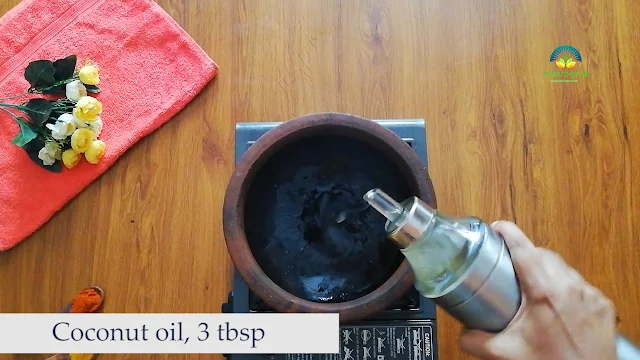 |
| Thengapal mean curry - Adding coconut oil |
Step 2: Tempering with Fragrant Fenugreek Seeds
As the coconut oil heats up in the wide-mouthed earthen pot, wait for the telltale signs of its readiness. Once the oil turns hot and begins to shimmer, it's time to introduce the aromatic fenugreek seeds into the mix.
With the pot now at the perfect temperature, carefully add the fenugreek seeds to the oil, and let them sizzle and release their enticing fragrance. This process takes hardly two to three seconds, so keep a watchful eye to prevent overcooking.
Fenugreek seeds not only serve as flavor enhancers in Thenga Paal Meen Curry but also offer digestive benefits. This humble spice complements the overall taste profile of the dish while aiding in the digestion of the delectable feast that awaits.
As the alluring aroma of fenugreek fills the air, you'll know that this traditional tempering technique has set the stage for a symphony of flavors to come. So, with the first steps complete, let's move on to the next stage of this culinary voyage - adding the key ingredients that bring Thenga Paal Meen Curry to life.
 |
| Thengapal meen curry - fengugreek seeds to hot oil |
Step 3: Adding Fragrant Curry Leaves
As the sautéed onions, green chilies, and ginger infuse the earthen pot with their inviting flavors, it's time to introduce the aromatic charm of curry leaves. With utmost care, toss one or two sprigs of curry leaves into the pot, letting them dance in the medley of ingredients.
Curry leaves, a quintessential component of South Indian cuisine, bring their unique citrusy fragrance and subtle bitterness to our Thenga Paal Meen Curry. As they mingle with the other ingredients, their essence enhances the dish, elevating it to a new level of taste.
Allow the curry leaves to release their enchanting aroma, merging harmoniously with the coconut oil and other spices. This delightful addition completes the flavor profile of our curry, promising a symphony of tastes that will leave your palate craving for more.
With the curry leaves adding their magical touch, our Thenga Paal Meen Curry is one step closer to becoming a culinary masterpiece. Let's continue our journey by incorporating the next essential elements that will transform this dish into a delectable delight.
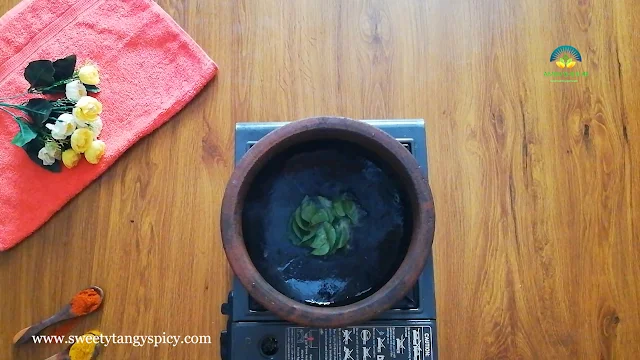 |
| Thengapal meen curry - curry leaves in |
Step 4: Sauteing Onions, Green Chilies, and Ginger
With the fenugreek seeds infusing the coconut oil with their delightful aroma, it's time to add the next layer of flavors to our Thenga Paal Meen Curry. Into the earthen pot, gently place the sliced onions, slit green chilies, and chopped ginger, as they sizzle upon contact with the seasoned oil.
Saute the ingredients until the onions turn translucent and acquire a hint of golden brown color. As the kitchen fills with their enticing fragrance, you'll know that this combination of aromatic ingredients is crucial to building the foundation of flavors for our curry.
The soft sweetness of the onions, the gentle heat of green chilies, and the zesty essence of ginger come together harmoniously, creating a symphony of tastes that will tantalize your senses. This sauteing process sets the stage for the next steps in our culinary adventure, as we continue to infuse our Thenga Paal Meen Curry with the rich heritage of Kerala's coastal cuisine.
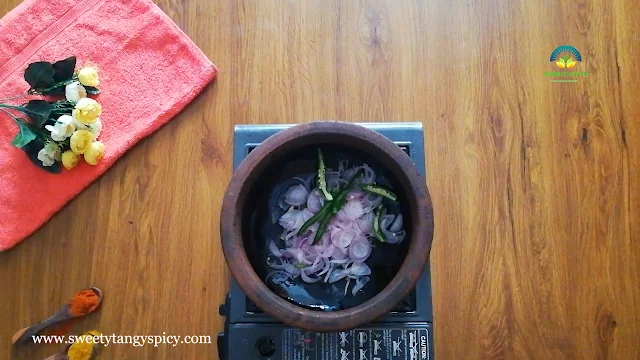 |
| Thengapal meen curry-onion, ginger plus green chilies |
Step 4: Sauteing Onions, Green Chilies, and Ginger
With the infusion of fragrant fenugreek seeds in the coconut oil, it's time to proceed with the next step in crafting our exquisite Thenga Paal Meen Curry. Into the earthen pot, gently place the sliced onions, slit green chilies, and chopped ginger, allowing them to sizzle as they make contact with the seasoned oil.
As the ingredients sizzle away, continue sautéing until the onions turn a delightful shade of golden brown. You have the option to keep the pot over medium or high flame, depending on your cooking preference. Should you choose the high flame option, remember to stir the ingredients continuously to ensure they don't burn.
The mesmerizing aroma that fills your kitchen signifies the successful combination of soft sweetness from the onions, a gentle heat from the green chilies, and the zesty essence of ginger. This sautéing process lays the foundation for the flavors to come, as we prepare to elevate our Thenga Paal Meen Curry to new heights.
Now, as the ingredients harmonize, we proceed to the next step - infusing our curry with the delightful tanginess of kokum or raw mango, adding a burst of flavor that tantalizes the taste buds. So, let's move ahead with the culinary journey and continue savoring the traditions of Kerala's coastal delicacies.
 |
| Thengapal meen curry-sautéed onion |
Step 5: Introducing Vibrant Spices
As the onions take on a delightful golden brown hue, it's time to infuse our Thenga Paal Meen Curry with a burst of flavors. With the flame lowered to low or turned off, swiftly add the red chili powder and turmeric powder to the sautéed ingredients.
Be vigilant and sauté the spices immediately, stirring them until the raw aroma vanishes. This process ensures that the spices bloom and release their full potential, awakening the senses with their vibrant colors and captivating fragrance.
The combination of red chili powder and turmeric powder brings a delightful warmth and earthiness to the curry, setting the stage for a spicy and richly hued dish. As the raw essence of the spices dissipates, you'll witness the curry's transformation into a tantalizing visual and aromatic delight.
With the spices now perfectly blended into the sautéed mix, our Thenga Paal Meen Curry reaches a crucial stage in its preparation. The stage is set for the next step, where we'll introduce the star of the dish - the tender mackerel fish - and luxuriate it in the creamy embrace of coconut milk. So, let's proceed to the heart of this delectable recipe, where flavors merge to create a symphony of taste and texture.
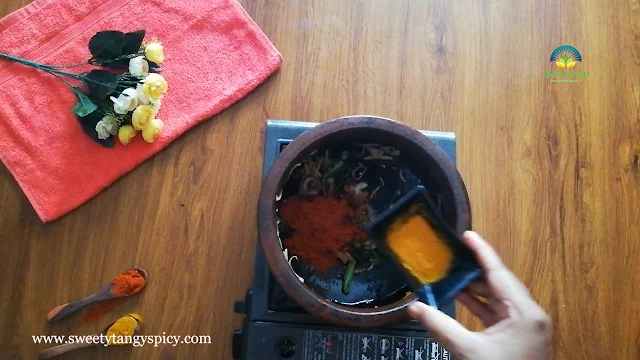 |
| Thengapal meen curry - adding spices |
Step 6: Simmering with Coconut Milk
With the spices now perfectly integrated, it's time to add a luscious touch to our Thenga Paal Meen Curry. Pour half a cup of creamy coconut milk into the earthen pot, gently enveloping the sautéed ingredients with its richness.
In Kerala's coastal kitchens, coconut milk plays a central role, and there are variations in its usage. Some prefer using only one batch of thick coconut milk (thalapal), while others combine both thick coconut milk and thin coconut milk (randam paal) for added richness. If you choose the latter option, add the thin milk at this stage, reserving the thick milk for later.
In Kerala's coastal kitchens, coconut milk plays a central role, and there are variations in its usage. Some prefer using only one batch of thick coconut milk (thalapal), while others combine both thick coconut milk and thin coconut milk (randam paal) for added richness. If you choose the latter option, add the thin milk at this stage, reserving the thick milk for later.
After adding the thick coconut milk, take a moment to gently mix the ingredients. Be cautious not to let the gravy boil once the milk is added, as boiling may lead to curdling, compromising the velvety texture we aim to achieve.
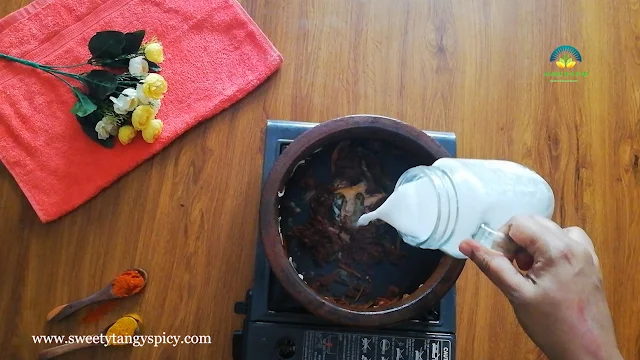 |
| Thengapal meen curry- coconut milk |
Step 7: Final Touches with Coconut Milk and Gambooge
As our Thenga Paal Meen Curry continues to embrace its creamy essence, it's time to take it to the next level of indulgence. Pour the remaining portion of coconut milk into the pot, immersing the sautéed ingredients in a velvety pool of richness.
Now, for the crowning touch of tanginess, add gambooge or kudampuli to the curry. The quantity of gambooge may vary depending on its potency and your personal taste preferences. Different brands of gambooge can have different strengths, so it's best to adjust the amount accordingly.
For this particular preparation, we used four pieces of gambooge, providing the perfect balance of sourness to complement the creamy coconut milk. Before adding the gambooge, ensure you wash and soak it for a few minutes, softening it to release its tangy essence effectively.
With the gambooge added, our Thenga Paal Meen Curry reaches its crescendo of flavors, harmoniously blending the creaminess of coconut milk with the tantalizing tanginess of gambooge. The curry is now complete, and the kitchen is brimming with the irresistible aroma of this coastal delight.
As you eagerly anticipate the final result, let the gambooge work its magic, lending its unique charm to this beloved dish. The stage is set for the grand finale, where we'll add the tender mackerel fish, allowing it to luxuriate in the enticing amalgamation of flavors we've meticulously crafted.
Prepare your taste buds for a feast, as we bring this culinary journey to its conclusion, culminating in an unforgettable Thenga Paal Meen Curry experience that captures the heart and soul of Kerala's coastal cuisine.
 |
| Thengapal meen curry - Kokum |
Step 8: Seasoning and Boiling the Gravy
With the curry now enriched with the creamy coconut milk and tangy gambooge, it's time to add the essential finishing touch - salt to taste. Season the curry with salt, ensuring it balances the flavors to perfection, enhancing the entire culinary experience.
Once seasoned, turn up the heat and allow the gravy to come to a boil over high flame. This final stage is crucial, as boiling helps the flavors meld together, creating a harmonious symphony that will leave your taste buds singing with delight.
As the Thenga Paal Meen Curry reaches its crescendo, the captivating aroma fills your kitchen, heralding the imminent indulgence in this coastal delicacy. Now, you're just moments away from savoring a dish that encapsulates the essence of Kerala's culinary heritage.
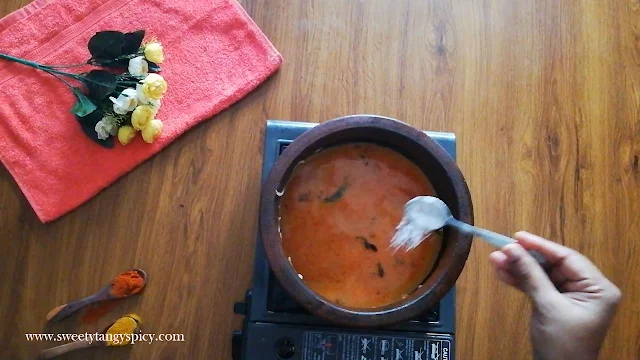 |
| Thengapal meen curry - adding salt |
Step 9: Adding the Tender Fish Pieces
As the Thenga Paal Meen Curry comes to a rolling boil, it's time to introduce the star of the dish - the tender mackerel fish. Gently place the fish pieces into the curry, allowing them to immerse themselves in the flavorful concoction.
To ensure the fish is evenly distributed without disrupting the delicate texture, gently shake and swirl the pan. At this stage, avoid using a spoon or any other utensil to mix the curry. The gentle swirling motion allows the fish to integrate beautifully with the coconut milk and spices, preserving the integrity of each element.
The tender fish absorbs the velvety richness of the coconut milk, embracing the aromatic spices and tangy gambooge. Every morsel becomes a delightful marriage of flavors, evoking the essence of Kerala's coastal cuisine with each bite.
As the curry simmers and the fish cooks to perfection, the flavors meld together, creating a symphony of taste that will leave you longing for more. With the tantalizing aroma wafting through the air, your anticipation grows, eager to relish the masterpiece that has unfolded in your kitchen.
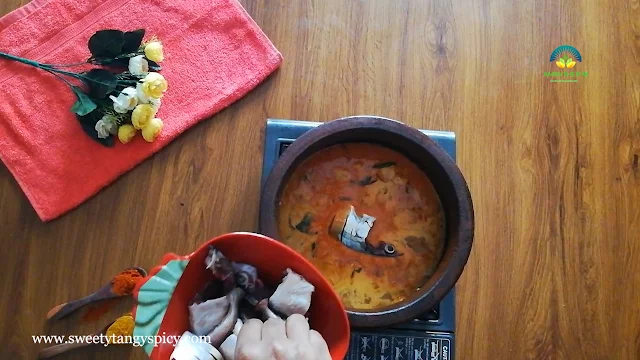 |
| Thengapal meen curry -Adding fish into the spicy gravy |
Step 10: Simmering to Perfection
With the tender fish pieces nestled in the flavorful Thenga Paal Meen Curry, it's time to bring this culinary journey to its final phase. Cover the earthen pot with a lid, allowing the curry to simmer gently over low heat.
As the curry simmers, its flavors intensify, and the gravy reduces to a delectable thickness. Keep a watchful eye on the process, and don't forget to swirl and shake the pan two to three times in between. This gentle motion ensures that the fish and spices intermingle harmoniously, infusing every bite with the essence of Kerala's coastal delights.
The slow simmering process allows the ingredients to meld together, transforming the curry into a symphony of taste. As the oil thickens, it imparts a glossy sheen to the dish, signifying the perfect fusion of flavors.
 |
| Thengapal meen curry-cooking fish over low flame |
Step 11: Tasting and Allowing Resting Time
With the Thenga Paal Meen Curry now simmered to the desired thickness, it's time to indulge in the ultimate pleasure - a taste test. Take a spoonful of the flavorful curry, savor its exquisite blend of spices and the creamy coconut milk, and assess if any adjustments to the spices or salt are needed. This step ensures that the dish is perfectly seasoned to your liking, elevating your dining experience to perfection.
Once the seasoning is to your satisfaction, turn off the flame and let the curry rest for the next one to two hours. This resting period is a vital secret of the recipe, allowing the tender fish to absorb all the spices, enveloping themselves in the flavors of Kerala's coastal heritage. The slow infusion process ensures that each bite of the Thenga Paal Meen Curry delivers a symphony of tastes, leaving you captivated by the culinary artistry.
During this waiting time, the flavors intertwine, and the curry matures to its fullest potential, creating an even more tantalizing experience for your taste buds. As you patiently await the grand finale, the aroma will entice your senses, tempting you to delve into this exquisite dish.
After the resting period, the Thenga Paal Meen Curry is at its peak, ready to be served to your eagerly awaiting guests or loved ones. Prepare to embark on a culinary voyage that pays homage to Kerala's rich traditions and delivers an unforgettable taste journey, where each bite is a celebration of coastal delights..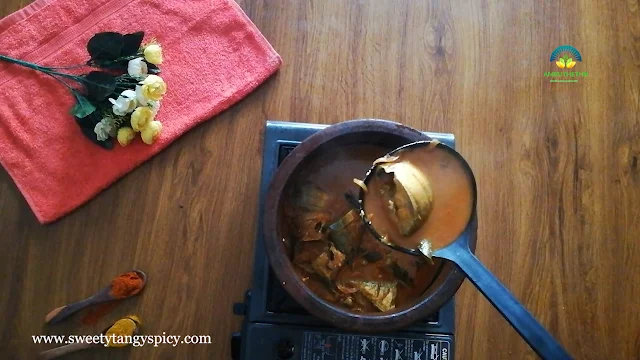 |
| Thengapal fish curry- fish curry is ready |
Adjusting the Spice Level and Consistency: Mastering the Perfect Thengapaal Meen Curry
As the Thengapaal Meen Curry simmers gently, it's essential to fine-tune the spice level and achieve the desired consistency. This step ensures that the curry perfectly suits your taste preferences, allowing you to savor the dish just the way you like it.
Step 1: Taste Test and Spice Adjustment - Take a moment to do a taste test. If you feel the curry needs more spiciness, you can add a pinch more of red chili powder or adjust it according to your preference. Remember, spices can vary, so trust your taste buds and make it just right for you.
Step 2: Consistency Control - Observe the gravy as it boils over high heat. Allow it to reduce until you achieve your preferred thickness. A rich and luscious gravy coats the tender fish pieces beautifully, enhancing the overall experience of the curry.
Step 3: Embrace the Resting Period - After the desired consistency is reached, switch off the flame and let the curry rest for the next one to two hours. During this time, the fish will absorb the flavors, and the curry will mature, intensifying the taste and aroma.
With these simple adjustments, you can tailor the Thengapaal Meen Curry to your liking, transforming it into a personalized coastal delight that brings joy to your taste buds. Enjoy the pleasure of culinary exploration and get ready to relish this tantalizing Kerala-style fish curry that captures the essence of tradition and coastal charm.
Pairing Suggestions: Elevating the Thengapaal Meen Curry Experience
To complete the Thengapaal Meen Curry feast and create a memorable culinary experience, consider these delightful pairing suggestions that complement the rich flavors of this Kerala-style fish curry. Each combination adds a unique touch, enhancing the overall dining pleasure and taking your taste buds on a delectable journey along the coastal delights of Kerala.
Steamed Rice: The classic pairing, steamed rice serves as the perfect canvas to soak up the velvety coconut milk gravy, allowing the flavors of the curry to shine through with every bite.
Mashed Tapioca: For a comforting and satisfying meal, indulge in the combination of Thengapaal Meen Curry and creamy mashed tapioca. The subtle flavors of tapioca meld harmoniously with the curry, creating a comforting symphony of tastes.
Dosa: Experience the fusion of South Indian flavors by serving Thengapaal Meen Curry alongside crispy dosas. The contrast of textures and tastes between the curry and dosa offers a delightful culinary adventure.
Idli: A match made in culinary heaven, the soft and fluffy idlis are a delightful companion to the flavorful Thengapaal Meen Curry. Together, they create a wholesome and satisfying meal.
Appam: Embrace the traditional charm by pairing Thengapaal Meen Curry with fluffy appams. The soft and lacy appams provide the ideal vessel to savor the essence of the curry.
Malabar Paratha: Explore the culinary fusion by serving Thengapaal Meen Curry with flaky Malabar parathas. The rich and buttery parathas perfectly complement the flavors of the curry.
Cucumber Raita: For a refreshing contrast, serve a side of cucumber raita alongside the Thengapaal Meen Curry. The cool and creamy raita balances the spiciness of the curry, creating a harmonious blend.
Coconut Chutney: Celebrate the essence of coconut with a side of coconut chutney. The sweet and nutty flavors of the chutney harmonize beautifully with the coconut milk-based curry.
By experimenting with these pairing suggestions, you can create a customized dining experience, infusing each bite with the rich traditions and coastal delights that Thengapaal Meen Curry has to offer. Whether you choose a classic combination or venture into new culinary territories, every pairing promises a memorable and flavorful journey for your taste buds. Enjoy the delicious exploration and relish the magic of Kerala's culinary heritage.
Storage and Reheating: Keeping the Thengapaal Meen Curry Fresh
Once you've savored the delectable Thengapaal Meen Curry, you might find yourself with some leftovers or wanting to make the dish ahead of time. Proper storage and reheating ensure that you can enjoy the flavors of this coastal delicacy even on subsequent meals.
Storage:
Refrigeration: To store any leftover Thengapaal Meen Curry, transfer it into an airtight container and refrigerate it promptly. Properly stored, the curry can last for up to 2 to 3 days.
Freezing: If you plan to store the curry for a longer duration, freezing is an option. Place the cooled curry in an airtight freezer-safe container, leaving some space for expansion. The curry can be frozen for up to 1 to 2 months without compromising its flavors.
Reheating:
Stovetop: When reheating refrigerated curry, gently warm it over low to medium heat on the stovetop. Stir occasionally to ensure even heating and prevent sticking.
Microwave: For a quick reheating option, use the microwave. Transfer a portion of the curry to a microwave-safe dish and heat in short intervals, stirring in between, until thoroughly warmed.
Thawing Frozen Curry: If you have frozen the curry, thaw it overnight in the refrigerator before reheating. Once thawed, follow the same reheating methods mentioned above.
Tip: To maintain the curry's original consistency and taste, add a splash of coconut milk or water while reheating, if needed.
By storing and reheating the Thengapaal Meen Curry properly, you can continue to relish its flavors, ensuring that each serving is as delightful as the first. Whether you enjoy it on the same day or as a make-ahead meal, the heartwarming taste of this coastal favorite will continue to captivate your taste buds.
Variations and Customizations: Personalizing the Perfect Thengapaal Meen Curry
Thengapaal Meen Curry is a versatile dish that welcomes creative variations and customizations. Infuse your culinary expertise and personal preferences to tailor this traditional Kerala-style fish curry to your liking. Here are some delightful variations and customizations to inspire your culinary creativity:
Fish Selection: Experiment with different fish varieties to discover new flavors and textures. While the recipe traditionally calls for fish with soft flesh, you can try using other fish like pomfret, seer fish, or even prawns to add a unique twist to the curry.
Vegetarian Twist: For those seeking a vegetarian version, substitute fish with tofu or paneer to create a delectable vegan alternative. The creamy coconut milk and tangy kokum will beautifully complement the plant-based protein.
Spice Level: Adjust the spice level according to your taste preferences. If you enjoy a spicier kick, increase the red chili powder or add some freshly ground black pepper for an extra zing.
Vegetable Medley: Enhance the nutritional profile by incorporating an assortment of vegetables like drumsticks, okra, or eggplant. These vegetables not only add depth to the curry but also provide a delightful contrast of flavors.
Coconut Variations: Experiment with different types of coconut milk. Use freshly extracted coconut milk for a rich taste, or opt for canned coconut milk for convenience without compromising on flavors.
Tamarind Tang: If you can't find kokum, try using tamarind pulp for that tangy flavor. Soak tamarind in warm water, extract the pulp, and add it to the curry for a delightful variation.
Aromatic Herbs: Enhance the aroma with the addition of curry leaves, cilantro, or fresh mint. These herbs elevate the fragrance of the curry, making each spoonful a delightful experience.
Creamy Indulgence: For a touch of indulgence, swirl in a tablespoon of thick cream or coconut cream before serving. This adds a luxurious creaminess to the curry, making it an irresistible treat.
Remember, the joy of cooking lies in experimentation and discovery. Feel free to adapt the Thengapaal Meen Curry to your taste preferences and dietary choices. Embrace your creativity and explore the myriad possibilities that this beloved Kerala dish offers. The result? A truly personalized Thengapaal Meen Curry that reflects your culinary passion and love for coastal delights. Enjoy the journey of flavors, and create cherished memories with every delectable bowl.
Cultural Significance and Festive Occasions: Celebrating Thengapaal Meen Curry
Thengapaal Meen Curry holds deep cultural significance in Kerala's culinary heritage. Beyond being a delectable dish, it carries stories of tradition, coastal life, and the joy of community gatherings. This cherished curry plays a vital role in various festive occasions, making it an integral part of Kerala's culinary celebrations.
Festive Occasions:
Eid and Christmas: The rich and flavorful Thengapaal Meen Curry holds a special place during festive celebrations, be it Eid or Christmas. It brings families and friends together to enjoy the goodness of coastal cuisine and create cherished memories.
Cultural Significance:
Coastal Delights: Being a coastal state, Kerala's cuisine revolves around the abundance of seafood. Thengapaal Meen Curry epitomizes the flavors and culinary traditions of the coastal communities, reflecting the close bond between Kerala's culture and its bountiful waters.
Symbol of Togetherness: Preparing and relishing Thengapaal Meen Curry often involves collective efforts, symbolizing the spirit of togetherness and harmony in Kerala's rich cultural fabric. It exemplifies the joy of sharing delicious meals with loved ones.
Ancestral Wisdom: Passed down through generations, Thengapaal Meen Curry recipes encapsulate the ancestral wisdom and culinary expertise that define Kerala's cultural heritage. Each preparation becomes a tribute to age-old traditions and time-honored practices.
Feast for the Senses: Thengapaal Meen Curry indulges all the senses - the sight of vibrant colors, the aroma of coconut and spices, the taste of creamy goodness, and the feel of tradition unfolding on your plate. It's a feast that leaves a lasting impression.
Embrace the cultural significance and festive charm of Thengapaal Meen Curry as it brings joy and celebration to your table during festive occasions and everyday gatherings. With every bite, you'll experience the flavors of Kerala's coastal heritage, forging a connection between the past, present, and future - a truly special experience to cherish.
Personal Stories and Anecdotes: A Taste of Tradition, Love, and Home
In the heart of Kerala's culinary journey lies the personal touch and cherished memories woven into every dish, and Thengapal Meen Curry is no exception. The soulful connection between food, family, and culture comes alive as we share personal stories and anecdotes that have nurtured this timeless coastal delicacy.
My Mom's Special Touch:
For me, Thengapal Meen Curry holds a special place, as it's a recipe that my mom lovingly passed down to me. Every lunchtime, I would watch with awe as she prepared the curry in an earthen pot over a slow flame. The aroma that wafted through our home was simply heavenly. This traditional method of slow-cooking fish in a spicy sour gravy is what adds that magical touch to the dish.
Ernakulam and Trissur Style:
Growing up in Ernakulam, we had our regional variations of Thengapal Meen Curry. The blend of spices, the choice of fish, and the balance of flavors often reflected the culinary styles of our area. It's fascinating to see how the same recipe can take on unique characteristics in different regions, enriching Kerala's culinary tapestry.
The Shallots vs. Savola Saga:
One delightful anecdote that often sparks conversations in many households is the shift from using shallots to savola (regular onions) in Thengapal Meen Curry. While modern convenience led to the adoption of savola, many still swear by the traditional charm of shallots. Our family is one such example - we still use shallots to recreate the authentic flavors that my grandmother once cherished.
A Dish of Unity and Love:
In every home, the preparation of Thengapal Meen Curry may have slight variations, but the love and unity it brings are universal. The joy of sitting down together to enjoy this aromatic and flavorsome dish creates heartwarming memories that last a lifetime. It's a dish that nourishes not just our bodies but also our souls.
As we savor the delightful Thengapal Meen Curry, let's treasure these personal stories and anecdotes, for they are the threads that weave a tapestry of tradition, love, and home. Each bite becomes a journey into the heart of Kerala's coastal delights, embracing the spirit of community and the simple pleasures of shared meals.
Final Thoughts: Savoring the Essence of Thengapal Meen Curry
As we reach the end of this culinary adventure, I am filled with immense joy and gratitude for being able to share the timeless charm of Thengapal Meen Curry with all of you. This beloved recipe, nurtured through generations, embodies the spirit of Kerala's coastal heritage and the warmth of family traditions.
In the gentle simmering of fish within spicy and tangy coconut milk, we find a tale of flavors that connect us to the bountiful waters of Kerala and the love that goes into each preparation. The subtle variations in different regions and homes add to the diversity that makes Kerala's cuisine so captivating and enchanting.
This cherished Thengapal Meen Curry not only indulges our taste buds but also touches our hearts, creating cherished memories of shared meals and heartwarming moments. It's a dish that unites families, brings friends together, and invites new friendships around a table filled with the essence of Kerala's culinary delights.
As you embark on your journey to recreate this delectable coastal delicacy, I encourage you to add your own personal touch, infusing it with the flavors and stories that make it uniquely yours. Embrace the joy of cooking and the happiness that comes with sharing your culinary creations with loved ones.
May every spoonful of Thengapal Meen Curry transport you to the sun-kissed shores of Kerala, where the waves dance to the rhythm of tradition and the aroma of spices fills the air. Let this recipe be a reminder of the simple pleasures and rich experiences that await in the world of culinary exploration.
From my kitchen to yours, I extend my heartfelt gratitude for being a part of this culinary journey. May your Thengapal Meen Curry be filled with love, joy, and the spirit of Kerala's coastal delights. Happy cooking, and may each meal be a celebration of flavors and togetherness!
With warmest regards,
[Anju ]




















0 Comments